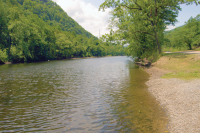In the shadow of Duke dams, heavy rains can trigger downstream flooding
 With September’s tropical storm season gearing up, residents living downstream of large Duke Energy dams in Western North Carolina may spend the fall on high alert, wondering when and if Duke will open the flood gates to release pent-up water from its dams on the Nantahala and Tuckasegee rivers.
With September’s tropical storm season gearing up, residents living downstream of large Duke Energy dams in Western North Carolina may spend the fall on high alert, wondering when and if Duke will open the flood gates to release pent-up water from its dams on the Nantahala and Tuckasegee rivers.
With no path to follow other than the riverbed, the surge of water floods downstream and sometimes jumps the banks flooding riverside houses.
The heavy rains this summer prompted Duke to open flood gates on both rivers, sending Jackson and Swain county emergency officials scrambling to warn residents about the potential for impending floods.
In early July, Duke told Jackson County Emergency Management Director Todd Dillard it was opening the dam gates at Lake Glenville because water levels in the lake had gotten too high.
“We just had a couple hours notice,” Dillard said. “This was one of those short notice events.”
Related Items
The county used its alert system to inform residents via phone, text or email about the high water about to surge down the Tuck. Although it was late in the evening, in no time, dozens of fire and rescue personnel were knocking on doors of houses in the low-lying areas or close to the river banks — from Glenville to Dillsboro — and assembling a makeshift emergency shelter. Seven people showed up at the shelter, located in a county senior center.
Downstream flooding wasn’t as bad as it could have been had the rain not stopped when it did. Duke was able to shut the flood gates back again after a matter of hours sparing extensive property damage.
“Everything went really well,” Dillard said. “But can’t say it will go that well the next time.”
Like Jackson, Swain County had to deal with several unplanned water releases coming off Nantahala Lake throughout the summer as well. A riverside campground even had to be evacuated. But Swain County Emergency Management Coordinator David Breedlove said he’d welcome a controlled release any day over the alternative. Rain and dam releases filled the Nantahala River to the brim, and sometimes over, during July.
“You can let it out in a measured manner, in which it is controlled and you notify people downstream,” Breedlove said “Or failure to do so can cause catastrophic failures.”
The brunt of hurricane season is yet to come, bringing the risk of prolonged heavy rain should storm systems settle in over the mountains, as was the case in 2004. On the heels of such a wet summer, there’s not much capacity to absorb a major rainfall.
“This would be a good season not to have a tropical system,” Dillard said.
While the region is at the mercy of the weather, in many ways, it’s also at the mercy of Duke. Dillard said the company is always diligent in letting local emergency personnel know when it will release water, but when the phone call comes, he knows he better get moving.
When Duke opens the dam on short notice it is primarily to prevent water from splashing over the top of its floodgates, said Lisa Hoffmann, a spokesperson for Duke.
“Even though it can cause some issues in low-lying areas, it is better than the other way,” Hoffmann said.
Despite what people think, the gates are not opened to prevent the dam from collapsing. The dam walls are built to withstand floods beyond what has ever been seen in recorded history, she said.
The flood gates are opened to keep the gate mechanisms from being broken should heavy debris be carried over the top of the gates by raising water, Hoffmann said. Only enough water is released to bring reservoirs down to normal levels, she added.
Another method for controlling water is to pre-drain a reservoir. In anticipation of the early July rains, Duke ran turbines to push water out of its reservoirs, Hoffmann said. However, relentless rainfall and a saturated ground caused the reservoir levels to rise faster than anticipated, she said, forcing Duke to open its flood gates anyway.
“It was out of our control so to speak,” Hoffmann said.
She also pointed to record rainfall in the region. Glenville Lake received 30 inches more rain from January through mid-July this year than it does in a typical year.









